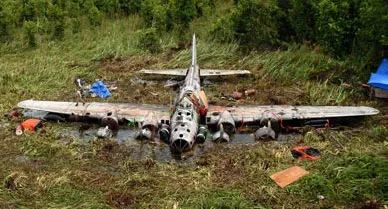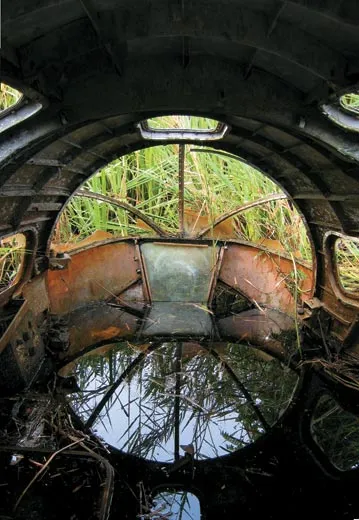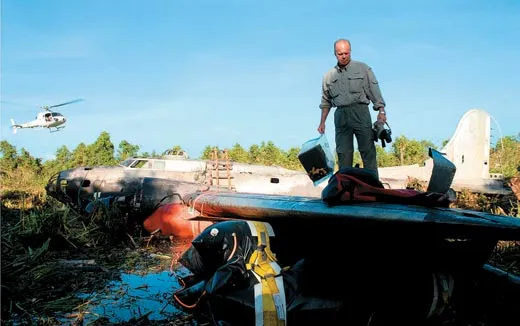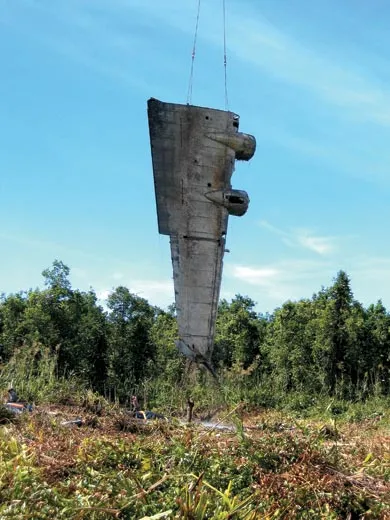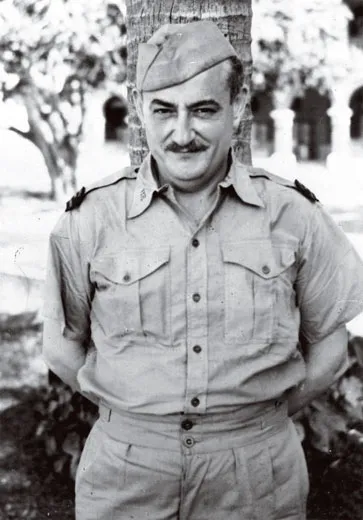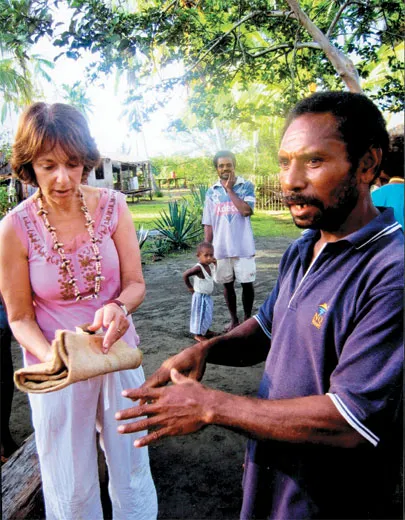Swamp Ghosts
In Papua New Guinea, a journalist investigates the controversy over a World War II bomber
Papua New Guinea—or PNG as it's called, sometimes with affection, sometimes in exasperation—is the kind of place tourist brochures describe as "the land that time forgot." It would be just as accurate to call it "the land that forgot time." Schedules are not rigidly adhered to. In the capital, Port Moresby, young men with no visible means of support hang out along the roads and markets, giving the place a laid-back feel but making it dangerous at night. The topography of mountains and jungle, beautiful but almost impassable, renders national identity elusive. The six million-plus people—80 percent of whom live in remote villages—speak about 850 languages, owe allegiance largely to local clans and eke out a subsistence existence hunting wild pigs and growing papaw and yams and other foods. Many lives have hardly changed from past centuries, except that cannibalism all but petered out in the mid-1970s, and, with the blessings of missionaries, a lot of people now wear castoff Western shirts and shorts. (It's not unusual to encounter a fisherman paddling a dugout canoe wearing, say, a Bucky Badger T-shirt from the University of Wisconsin.)
This past May, I visited PNG because I was eager to see the country where my father was killed in World War II. He was a war correspondent for the New York Times—Byron Darnton was his byline—and the troopship he was on was bombed as it was about to disembark soldiers onto a sandy beach in October 1942. I was 11 months old at the time and so have no memory of him. But of course New Guinea was always more than a dot on the map for me. In our living room we had a patriotic globe with stars to mark major American battlefields. In my childhood naiveté, I thought the manufacturer of the globe had put the one on Buna, on the northern coast of what was then called Papua, to commemorate the spot where my father fell.
New Guinea was conscripted into war, caught between the Japanese and the Allied counteroffensive from the south. For the most part Papuans did not fight, but both sides pressed many into service as bearers, carrying supplies and stretchers of wounded men across mountains and through miles of steaming jungle. (Their nickname, unthinkable today, was Fuzzy Wuzzy Angels.) Almost all of them have died by now. Yet the war seems anything but remote, largely because its rusting relics are so much a part of the landscape. Sunken freighters, submarines and troopships rest on the bottoms of harbors and hidden bays. The blackened hulls of bombed-out planes sit beside old airstrips, and debris from hundreds of crashed planes lies camouflaged in the mountainous rain forests and lowland jungles. So many soldiers died—including many thousands of Japanese never accounted for—that even today, after heavy rains, villagers report an occasional skeleton rising up in the mangrove swamps like a mummy in a horror movie.
It's not surprising, then, that PNG has become favored terrain for war buffs. (Last year, an estimated 4,000 people made the grueling weeklong trek on the Kokoda Trail across the Owen Stanley Mountains, where Australian soldiers pushed back the Japanese; as recently as ten years ago only about 100 made the hike.) Poking around the pillboxes and overgrown ruins of the Japanese bases at Buna and Gona, Australian, American and Japanese tourists bump into one another, sometimes in awkward silence. Perhaps more than anything else, PNG has become a hunting ground for "warbird" enthusiasts looking for missing plane wrecks. Passionate treasure hunters, they like nothing better than to hop into helicopters for spotting missions, hack through the baking, merciless jungle, debrief villagers and hire local guides, all for that magical moment when they might uncover a Kittyhawk or Bristol Beaufighter that dropped out of the sky more than 60 years ago. Among them are a special breed, the salvagers, who not only locate the planes but also extract them, or pieces of them, for export, usually selling them to museums or to private collectors.
Of all the wrecks on PNG, none is as fabled as the "Swamp Ghost," a B-17E Flying Fortress that ran out of fuel on an ill-fated bombing mission in early 1942 and was ditched in the Agaiambo Swamp about eight miles inland on the northern coast. There the plane rested, intact and more or less unmolested, in soggy splendor for 64 years—that is, until May 2006, when an American salvager took it apart and removed it. This caused such a controversy that the plane was stopped from leaving the country. It sits crated in a warehouse near the coastal town of Lae. The episode raises what has become a burning issue: Who has the right to sell war surplus and what should be done with it in the face of a burgeoning international market? The debate, which taps into anger over the growing realization that the island's natural resources are being exploited by illegal loggers and rapacious mining companies, has roiled Parliament and the government of Sir Michael Somare, the imposing leader who has served, off and on, as prime minister ever since he led the country to independence from Australia in 1975.
The salvagers claim that the villagers near the crash site were persuaded to give up the relic and that a local chief even performed a ceremony to appease the spirits of the swamp. But other Papuans, who have a deep attachment to ancestral land and are apt to extract money from strangers just to set foot on it, clearly feel different. Augustin Begasi, the 39-year-old son of a chief of the coastal village of Bendoroda, organized a group to try to intercept the plane before it reached a barge offshore. The salvagers claim the posse wanted to extract money because the barge was in their waters. In any case, Begasi and company were dispersed by police, who they believe were paid by the salvagers or someone else to help get the plane out. Begasi couldn't have stopped it anyway, since the plane was ferried out overhead by a Russian-built military helicopter; he could only watch as it was lifted out to the barge.
"They should have given us money, because it was our accustomed land," Begasi told me. "The plane would bring tourists, but now there is nothing. That village has no name now. If they left it there, it would have a name by now."
Something about the Swamp Ghost, I came to learn, drives people around the bend.
I first learned about the plane from Justin Taylan, a 29-year-old bachelor from Hyde Park, New York, whose consuming interest in the Pacific theater dates back to a particular day in 1992. An eighth grader then, he had asked his grandfather, Carl Thien, who had served as a combat photographer there, to help him with a school report about the B-29 bombing campaign of Japan. "He became furious with me and said: ‘We were fighting in New Guinea long before there were any B-29s.'" Thien took him aside and gave him a firsthand education in the horrors of hand-to-hand jungle fighting. Later that year, the two visited PNG; Justin climbed all over a wrecked Japanese bomber and was hooked. Today, after seven more visits to PNG, Taylan pursues a hobby that is all-consuming. He searches out wrecks, returns dog tags and other artifacts to surprised owners, produces DVDs and runs a Web site (PacificWrecks.com) that draws 45,000 hits a month.
The law on ownership of salvaged wrecks has evolved over the years. Basically, the U.S. Navy does not relinquish claims to ships or aircraft, whether sunken or above water. The Air Force, under a decision from its general counsel, regards any plane that crashed on land before November 1961 as abandoned, and hence fair game for salvagers. That is not true, however, for a plane that crashed and sank in water, which presumably means at sea, not in a swamp. (Though who knows? A sharp lawyer might have fun trying to parse that.)
Taylan said the name Swamp Ghost was coined when Australian troops "rediscovered" the plane on maneuvers 35 years ago. Spotting it from a helicopter, they landed on the plane's wing and found the semi-submerged aircraft eerily untouched. The machine guns were in place, fully loaded, and in the cabin there was a thermos with what used to be coffee inside. Some claim there was even an ashtray with cigarette butts. The nickname stuck, and over the years missionary pilots and others used the wreck as a navigational reference point. Sometimes, with the coating of camouflage olive paint burned off the roof by the sun, its aluminum skin gleamed in the sunlight like a giant silver dagger, visible for miles around. Other times, when the kunai grass grew 12 feet high and engulfed it, the Swamp Ghost dropped from sight, making the nickname all the more appropriate.
"On my first visit, in 2003, I'll never forget clearing away the kunai grass," Taylan told me, speaking rapidly in his excitement. "It revealed the sides, and I saw the U.S. Army Air Forces markings, a white star with a large red dot in the center—they called it a ‘meatball' in those days, and it was later phased out because it was thought it might be confused with the Japanese rising sun. And the sides were in perfect condition. It was just spectacular. It was like stepping back in time, back to 1942, to see the plane and the ‘meatball' and the door on it, the waist door, still propped open 45 degrees. You could imagine the crew leaving it."
The crew's fate, in fact, is part of the plane's mystique. On the first long-range bombing mission against the Japanese, the B-17 took off from Australia just before midnight on February 22 with the aim of attacking ships at Rabaul on Japanese-held New Britain at dawn. From the outset the mission was plagued by mishaps. With bad weather, incomplete maps, novice pilots and mechanical problems, four of the nine bombers never even got off the ground. "It was dark as hell at night," recalled Clarence LeMieux, the engineer, now 90 years old and living in Spokane, Washington. "By the time we got there, we lost all the other planes but ours and one more. We ran into tornadoes—three or four of them—and we couldn't even see the harbor." What happened next is debated—some say the bomb bay doors didn't open—but in any case the plane made a wide circle and came in for a second run before it dropped its load. Then it fought off half a dozen Japanese Zeros, had its right wing shot through by an antiaircraft shell that didn't explode, climbed to shake off pursuers and headed off. All of this took a toll on fuel. Capt. Fred Eaton hoped to make it to Port Moresby, which meant flying over the mountains. "I looked over at the fuel gauges, and they were pretty damn low," said LeMieux. "I said: ‘We're not going to make it with this fuel.' We saw what looked like a wheat field—all this pretty grass—and Fred says, ‘Let's put her down here.' "
The belly landing was perfect; only the propellers were bent. But when the doors were opened, the crew men realized they had set down in four to eight feet of water. "We jumped off, and the damned stuff was up to our neck," said LeMieux. Only one of the nine was injured, the navigator, George Munroe, and only slightly. "We had these two thin sheets of wood in the bomb bay to keep the wind out of the compartment," Munroe, age 89, recalled from his home in Falls Church, Virginia. "And I stuck my head between them and got stuck there when the plane stopped. They pulled me out, and someone said: ‘My God, your throat's cut.' That kind of shakes you up. But they had a flask, and they poured water on me, and it turned out I had little scalp cuts."
For two days, the crew members hacked their way through razor-sharp kunai grass, trying to rest at night on makeshift mounds of it, which kept sinking. They were exhausted and famished. (Their emergency rations had sunk.) When they finally reached dry land, they were so badly bitten by mosquitoes they couldn't sleep. Several began to hallucinate. "A friend and I suddenly saw a mess hall," said Richard Oliver, the bombardier, at 87 long retired and living in Tiburon, California. "So we decided to get some ice-cold canned tomatoes. We could see the lights up ahead, and we headed off down the path to reach it, when, luckily, somebody yelled at us and woke us up."
The crew ran into some Papuans chopping wood. "They didn't seem threatening," said Munroe, "but I carried my .45 the whole time." In fact, the Papuans were friendly. They took the airmen to their village for the night, then put them in outrigger canoes and took them downriver to the coast, where they were handed over to an Australian resident magistrate. By now, most of the airmen had been stricken by malaria. After they made several abortive attempts to depart, a boat finally picked them up and took them to Port Moresby, arriving there on April 1—thirty-six days after the crash. They were given a week in a hospital and returned to combat. On many of his 60 subsequent missions, the pilot, Eaton, would often fly over the wreck, and whenever he did, he would circle it and regale his new crew members with the story of how all nine men had made it back to base alive. The Swamp Ghost's formidable legend was born.
After the war, the plane slipped into an oblivion that lasted almost three decades, until the Australian soldiers spotted it in 1972. They provided the tail number to the Americans, who traced it to the lost B-17. The crew was told about the discovery. Word began to get around, especially after 1979, when Charles Darby, an early "warbird" collector and chronicler, printed dozens of photos of it in his seminal book, Pacific Aircraft Wrecks. Bit by bit, as the fad to recover World War II aircraft took off, trekkers made it to the site. Over time the plane was stripped of its instruments, guns and even its steering assemblies (called flight yokes), though the structure itself, resting in fresh water, remained remarkably intact.
Among others, the young Taylan was inspired by the Darby photographs. "Some people set goals to become doctors or lawyers, but when I saw those pictures, I said to myself: ‘My God, this is like looking back in time. If I do anything with my life, I've got to get to this airplane.'" He managed to do just that, many times, and each trip fed his attachment to the plane. He began, as many visitors do, to feel protective about it, convinced that it should remain where it was, like a found art object that takes its meaning from its surroundings. In 2005, to support his contention that the wreck could attract adventurous souls and that this would be a boon to the nearby villages, he led 15 people on a hike to the plane. Then he joined up with a colorful local Australian expatriate, Dale McCarthy, who trucks palm oil and, on the side, runs a handsome fishermen's lodge at Bendoroda. Together they hatched a dream: bring in tourists who go in for rough travel; let them trek the Kokoda, fish for black bass at Bendoroda and hike through the swamp to lay eyes on one of the most famous war relics in all the Pacific.
Meanwhile, Alfred Hagen had set his sights on the Swamp Ghost. A 49-year-old aviator and commercial builder from Bucks County, he describes himself as "a carpenter from Pennsylvania with grandiose delusions." For more than a decade he has been plying the jungles of PNG in search of downed aircraft. His consuming preoccupation began in 1995 with a mission: to locate the site of the B-25 crash that killed his great-uncle, Maj. William Benn, a decorated flier and squadron leader. (Benn pioneered low-altitude "skip bombing," a way of releasing a bomb so that it skips across the water to its target.) Hagen succeeded in June 1998. The wreck was 500 feet from a mountain divide. Hagen surmised that an engine had failed and that the pilot had been searching for an uncharted pass. Two years earlier, in the course of Hagen's search, something happened that fixated him on the Swamp Ghost. He spotted its tail in the grass and jotted down the GPS coordinates. Then his plane, which had hit the top of a coconut palm, became disabled. It barely made it over the mountains. "We flew through a pass and could see all the stars and the Southern Cross and in the distance the lights of Port Moresby. In those moments, it was the closest I came to living my uncle's experience. I felt a connection."
Over the years, Hagen has found parts of seven other World War II aircraft in PNG, including a P-47 Thunderbolt, and in so doing has helped experts identify the bones of some 18 MIA American fliers, even attending burials back home for some of them. In one controversial instance, convinced that the bureaucratic wheels of the Army's Central Identification Laboratory in Hawaii were likely to move too slowly, he took it upon himself to call a family in Massachusetts and inform them that he had found the remains of the 22-year-old pilot whose loss they had been mourning for 51 years. He acknowledges that his call was "a gross violation of protocol," for which military authorities "called me a renegade, a loose cannon and everything else," but he is not a man to shy away from a confrontation—or a challenge. "One of the extraordinary things about what I've done is I wasn't qualified to do any of it," he said. "In life you don't have to be qualified. You just have to have audacity. I have audacity."
Like many others, Hagen has fallen under the spell of the Swamp Ghost. But unlike most, he feels the need to own it. Why? "It's the holy grail of military aviation." To leave it in the swamp, he asserts, would have been "obscene," because it was slowly but surely disintegrating. Hagen's company, Aero Archaeology, obtained an export permit for the Swamp Ghost from New Guinea's National Museum and Art Gallery in November 2005 in return for $100,000.
Earlier attempts to raise the plane, including one by the Travis Air Force Museum in California, which would have provided PNG's National War Museum with several restored planes, had dragged on in fruitless negotiations for more than ten years. But Hagen, armed with ample money and working with Rob Greinert, an Australian who has salvaged more than a dozen aircraft from PNG, was determined to press ahead. He assembled a crew of 43 people, including a B-17 mechanic, a specialty towing company from Penndel, Pennsylvania, and a five-man documentary film crew. The group labored for close to four weeks, raising the craft with weighted air bags, severing the wings, dismounting the four engines, removing the tail and lifting the fuselage. The operation was arduous—they had to contend with everything from crocodiles in their base camp to scorpions in their wading boots—but successful. Their Russian-built military helicopter hoisted out the various parts and placed them on the barge, waiting nearby. The left wing dropped from its sling half a mile from the site but was recovered and, according to the salvagers, suffered only minor damage. Some of the locals who worked with the salvagers—and who were paid handsomely—are content. "We heard a lot from our fathers about what it was like working with the Americans in the war," said Luke Nunisa, relaxing in the lounge of the luxurious Tufi Dive resort. "So it was a real opportunity to see them work. They treated us fairly."
But by the time the barge reached the coastal town of Lae and the plane was crated for shipping to the United States, the controversy over its removal—on New Guinea TV and in the main newspaper, the Post-Courier—had reached deep into the government. A special committee of Parliament found that the National Museum had no right to sell war surplus (only to document and monitor it) and insisted that the Swamp Ghost, belonging to the state, should not be permitted to leave the country. The committee said the plane was worth $3 million to $5 million and demanded that Hagen and Greinert be investigated by the Royal Papua New Guinea Constabulary for their roles in salvaging it. "The trade in war surplus materials is clearly big business," the committee concluded, and it said the museum, under "the improper influence of foreigners," had colluded in the illegal sale abroad of 89 planes or parts of planes, of which 85 ended up in the hands of private individuals, not museums.
The museum director, under pressure, asked the director of customs to hold off allowing the plane to be exported until a top government body, the National Executive Council, sorted out the mess. Hagen is sticking to his guns. His side claims that the parliamentary committee had an ax to grind and no jurisdiction in the matter. "I bought it legally, I salvaged it legally, I own it legally," he told me. "If they don't allow me to have it, how can any international corporation possibly do business with PNG?" He blames the media. "They drummed it up that I was raping New Guinea....Because I'm a businessman from America, [they say] I must have been involved in corruption because how else would I have gotten it." Hagen has launched a lawsuit, claiming upward of $15 million in expenses and damages, according to his local attorney, Camillus Narakobi. "We insist the board of trustees of the museum clearly has authority to execute salvages of this nature," Narakobi said.
If, as seems likely, Hagen does succeed in exporting the Swamp Ghost, it's not clear what will happen to it. His original plan was to restore it and fly it himself, but this would be costly. He has been talking with the Pima Air and Space Museum in Tucson, Arizona, and would like to lease it to that institution for display if he can take it up for a spin every so often. The museum is dubious, to say the least, about such an arrangement. This model of B-17 is relatively rare, the only one equipped with a remotely operated "belly turret." (The gunner lay on the floor and used a periscope to fire the machine gun.) Meanwhile, as the lawyers and politicians argue its fate, the Swamp Ghost remains crated in Lae. Every other week or so, a new rumor emerges that it's been smuggled out of the country.
Justin Taylan, whom Hagen accuses of fanning the flames of controversy, says he's devastated that the plane was removed from the swamp. He maintains that it had achieved an "equilibrium" there that would have more or less preserved it for years.
Some months back, he chartered a boat to grab a glimpse of it on the docks. "It was sad," he said, recalling the sight of the fuselage without wings or tail. "It was like seeing a classical statue missing its arms and legs." But he took consolation in one thing: "It's a ghost, and its spirit seems only to have grown."
The only people who seem totally uninterested in the plane's future are the three surviving crew members. "After so many years and so much discussion, I've got sick and tired of talking about it," said George Munroe. "A lot of people got taken with that plane, which baffles me. I'm just not very interested. To me, it's just trivia. We certainly weren't that heroic. None of us saved a maiden in a burning building."
A week after returning from PNG, I encountered a ghost of my own. I came across the name of the Swamp Ghost's pilot, Fred Eaton, who died in March 1994. It had been written on June 9, 1942, in a notebook of my father's that my family kept for more than six decades. He must have run across Eaton at one of the aerodromes where he went interviewing pilots looking for human-interest stories to send to the Times. His handwriting was slanted and, from the looks of it, hurried. After the pilot's name he wrote simply: "brought ship down into breast high water. 2 days cutting way thru high grass." Nothing else. My father apparently moved on to interview others. What a story he missed.
John Darnton was a foreign correspondent and editor at the New York Times for 39 years. He has also written four novels.
Planning Your Next Trip?
Explore great travel deals
Smithsonian magazine participates in affiliate link advertising programs. If you purchase an item through these links, we receive a commission.
